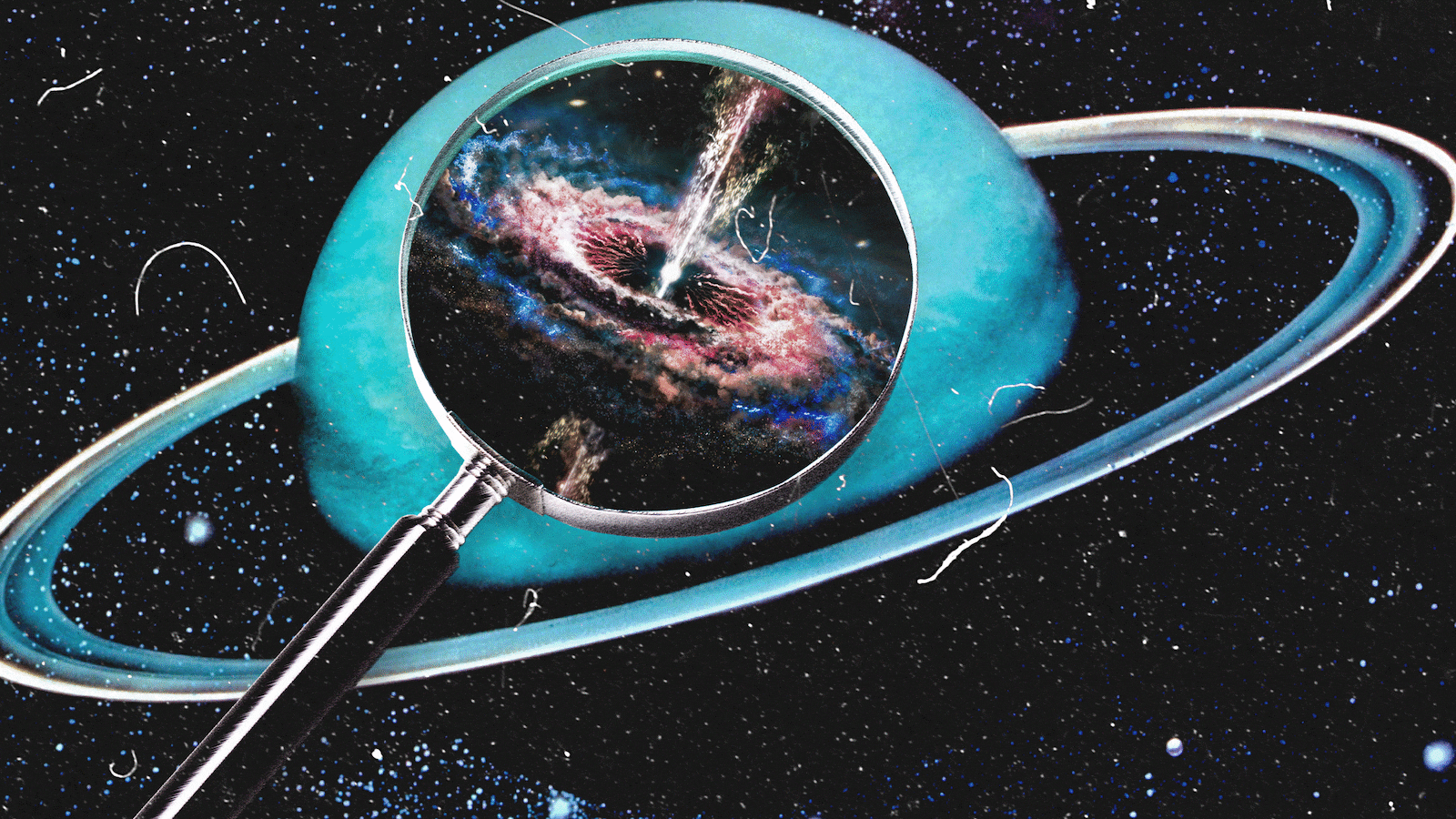Dark matter is strange, mysterious stuff. It might make up as much as 85 percent of the mass of the universe, and its gravity affects everything around it. But we can’t see it with our naked eyes. We’ve never directly observed it with any of our instruments, on Earth or zooming through space on some probe.
Now a Swiss team has drawn up an intriguing plan—a possible way to get a much more precise read on dark matter. It involves shooting probes toward the most distant planets in our solar system, Uranus and Neptune, and carefully logging every force tugging on their trajectories. If we subtract the known forces—the gravitational pull of every nearby planet, moon and asteroid—what’s left should be the effect of dark matter.
It’s a “unique opportunity” to “improve measurements of the standard gravitational parameters in the solar system,” Lorenz Zwick and his team from the Center for Theoretical Astrophysics and Cosmology at the University of Zurich wrote in a new peer-reviewed study that appeared online on April 22.
The Swiss plan looks great on paper. In practice, however, it might not be possible to separate the force of dark matter acting on a probe from, say, the force from some unmapped asteroid—or even a loose connector in the probe venting radiation into space. In other words, we might not know enough about the matter we can see to start inferring things about the matter we can’t see.
The going theory is that dark matter doesn’t interact with electromagnetic fields the same way visible matter does. It neither absorbs light nor reflects it. But we’re pretty sure it’s there. Without it, the universe doesn’t make sense. Planets and star systems and whole galaxies behave as though they weigh nearly twice as their visible mass seems to imply. There’s a lot more gravitational force than we can account for just by adding up the mass of objects in space.
The gap between what we can see and what we think is there first became evident in the early 20th century. The gap got bigger as our instruments got better. In the late 1960s, Seth Shostak, an astronomer now most famous for his work on SETI—the search for extraterrestrial intelligence—used a radio telescope array in California to determine that some galaxies were spinning faster than their visible stars indicated they would. Shostak later surmised the galaxies had mass we couldn’t directly observe.
Today, dark matter is integral to astronomy. But that doesn’t mean we understand it very well. For one, we don’t know how evenly it’s spread. It’s possible that dark matter is denser inside a star system than it is in the vast distances between systems. It’s also possible dark matter has contours inside a star system.
Zwick’s close survey of our own system could help us answer that question, with possible knock-on effects across the space sciences. “Pursuing new avenues like what is proposed here looks very exciting,” Priyamvada Natarajan, a Yale astronomer who specializes in mapping dark matter and wasn’t involved in the University of Zurich study, told The Daily Beast.
We might even be able to settle whether our solar system, or even just our corner of the solar system, is special. “Our current expectations for the [dark matter] density at Earth are based on observations of stars around the galaxy, combined with the assumption that Earth is in a fairly typical part of the galaxy for its distance from the galactic center,” Tracy Slatyer, an associate professor with the Center for Theoretical Physics at Massachusetts Institute of Technology who wasn’t involved in the study, told The Daily Beast. “It would be fantastic if we could test that assumption.”
Zwick’s idea is to launch a probe—or a couple of probes—toward the farthest big objects in the solar system: the icy planets Uranus and Neptune.
“Only Uranus and Neptune are sensible targets since the measurement is sensitive to the total enclosed mass of dark matter between the sun and the spacecraft,” Zwick explained to The Daily Beast. In other words, the farther away the targets of your probes, the more dark matter the probes have to travel through—and the more data they can help gather.
Controllers on the ground would carefully track the probes, noting every tiny change in course and velocity. Logging those changes is the whole point, actually. Each one hints at the influence of gravity—from a planet or moon or asteroid or something.
Or maybe even from dark matter. “The presence of [dark matter] would produce a radial force proportional to the enclosed mass within the spacecraft’s orbit,” the University of Zurich team wrote.
If Zwick’s team or other scientists could send probes to the outer edges of our system and keep track of them for a decade or so–and yes, Zwick has particular probes in mind that could launch in the next 15 years–they might have enough data to start weeding out the obvious influences on the probes’ journeys. What’s left might be evidence of dark matter.
Some dark matter experts are skeptical of the plan—but maybe not for the obvious reasons. Cost and technology, the usual obstacles to a new space mission, aren’t really the issues. After all, Zwick’s survey wouldn’t actually require its own spacecraft. Since all the dark matter scientists need to do is track a probe or two and build a model of gravitational forces on them, any probes will do as long as they’re traveling far enough.
So it makes the most sense to piggyback on existing spacecraft. Just tweak the radio link for the better telemetry data, and you’re ready to go investigate local dark matter. “In a sense, we are only hitchhikers,” Zwick said.
Perhaps the best candidates are a pair of probes that NASA wants to send to Uranus and Neptune in the late 2030s. The space agency hasn’t fully committed to the probes yet, so there’s no clear sense of what instruments they might carry or exactly when they might launch. Mark Hofstadter, a planetary scientist at NASA's Jet Propulsion Laboratory in California, stressed the “importance of exploring at least one of these planets and its entire environment, which includes surprisingly dynamic icy moons, rings and bizarre magnetic fields.”
Zwick and company are already making overtures to NASA. “If we can make a strong enough case and convince enough people, we hope that the idea will snowball, and that improving the radio link will become a priority in mission planning,” Zwick said.
But even if NASA signs on without delay, other complications could doom Zwick’s dark matter mission.
For starters, it’s possible that dark matter’s influence on a probe, even a far-flying one, would be really, really subtle. Perhaps too subtle to differentiate from a rounding error in our calculations of known gravitational influences. “There is no way that I know of to get the sensitivity needed to measure dark matter in the solar system purely through its gravitational effects unless the density [of dark matter] is far higher than we expect,” Slatyer warned.
Then there’s the prospect of unknown gravitational forces that aren’t dark matter. As much as Zwick’s proposed project is a matter of subtraction, it’s absolutely critical that we understand all the numbers. A previously unknown force, even a minuscule one, could throw off the whole project. “The precision one needs to achieve in the determination of motions of test objects in the gravitational field is… very high,” Francisco-Shu Kitaura, an astrophysicist at the Institute for Astrophysics in the Canary Islands and the University of La Laguna who wasn’t involved in the study, told The Daily Beast. Even Zwick and his team conceded that their proposal would only work “if all the forces acting on the real spacecraft are fully modeled.”
Incomplete modeling was behind one of the earliest dark matter disappointments. In 1972, NASA’s Pioneer probe launched on a mission to Jupiter. Controllers detected a small, unplanned acceleration. For a heady moment, some scientists believed it was evidence of dark matter tugging on the craft. They were wrong. “In the end, people realized that the spacecraft was emitting thermal radiation… which caused it to deviate slightly from its trajectory,” Zwick recalled.
Of course, it’s not 1972 any more. Our tech is better. And when it comes to dark matter, we have a clearer sense of what we’re looking for. Maybe Zwick’s mission to map invisible stuff, assuming it goes forward, will fail because we haven’t accounted for all the visible stuff… yet.
But it’d still be a probe or two in the right direction.










